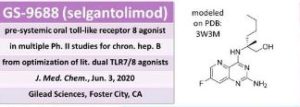SELGANTOLIMOD
GS 9688
RN: 2004677-13-6
UNII: RM4GJT3SMQ
Molecular Formula, C14-H20-F-N5-O,
Molecular Weight, 293.344
1-Hexanol, 2-((2-amino-7-fluoropyrido(3,2-d)pyrimidin-4-yl)amino)-2-methyl-, (2R)-
(2R)-2-((2-Amino-7-fluoropyrido(3,2-d)pyrimidin-4-yl)amino)-2-methylhexan-1-ol

Discovery of GS–9688 (Selgantolimod) as a Potent and Selective Oral Toll-Like Receptor 8 Agonist for the Treatment of Chronic Hepatitis B
Journal of Medicinal Chemistry, Articles ASAP (Drug Annotation)
Publication Date (Web):May 14, 2020DOI: 10.1021/acs.jmedchem.0c00100

PATENTS
| Patent ID | Title | Submitted Date | Granted Date |
|---|---|---|---|
| US2019192504 | Therapeutic heterocyclic compounds | 2018-08-20 | |
| US2017281627 | TOLL LIKE RECEPTOR MODULATOR COMPOUNDS | 2017-04-25 | |
| US2017071944 | MODULATORS OF TOLL-LIKE RECEPTORS FOR THE TREATMENT OF HIV | 2016-09-13 | |
| US9670205 | TOLL LIKE RECEPTOR MODULATOR COMPOUNDS | 2016-03-02 |
Patent
https://patentscope.wipo.int/search/en/detail.jsf?docId=US178076456&tab=PCTDESCRIPTION&_cid=P21-KD1F9D-27923-1
EXAMPLE 63
EXAMPLE 64
EXAMPLE 65
/////////////GS 9688, SELGANTOLIMOD
CCCC[C@@](C)















